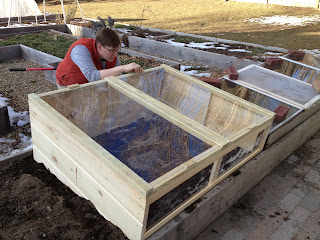New Cold Frames
Over the weekend, Kirk built a new cold frame:
Our old cold frames (one of which you can see to the right of the new one in the photo above) are full of plants from the winter and some salad-y seedlings we started at the beginning of March, so we need a few more to keep our early succession plantings going. Also, our old cold frames were built for our old garden, so they have a few weaknesses that we wanted to correct with the new ones.
First, our old cold frames are only three feet deep, which doesn't exactly cover four-foot deep beds.
Second, they are covered with a fairly random assortment of old storm windows. While these are effective, we have also lost several to the wind since they aren't attached, but rather held down by bricks.
Third, they are really, really heavy. They're about eight feet long and made of 2x12 boards, so once they are a giant pain to move around.
They certainly work, but we wanted to customize the new ones for our current garden space.
Obviously, the new ones are four feet deep, and fit right inside all of our raised beds, as you can see in the close-up above. They are also four feet wide, so it's basically a giant square. The smaller size makes them more modular and much easier to move around.
Also keeping these more lightweight are the materials: the new cold frames are made of 1x8 shiplap siding. The thinner boards may end up offering less insulation, but on the outside chance that this ends up being an issue, we can always surround them with some hay bales for warmth in the dead of winter. The shiplap was also nicely portable, as it comes in smaller pieces that you put together to form wider boards. Kirk used three pieces of siding, then cut the bottom on an angle with the table saw to create the slope from 18 down to 12 inches. This leaves the top all nice and square as a base for the lights.
The sides and back are all shiplap, while the front is framed to hold plexiglass:
As I mentioned, they are also much taller than our old ones (18 inches in the back and 12 inches in the front), which should better accommodate kale and anything taller than mache and spinach throughout the winter. But that height creates a big shadow, especially in the angle created by the winter sun. To alleviate that, we made the front plexiglass. The top lights are also plexiglass, which also helps keep these new cold frames light and portable.
In the photo above, Kirk is screwing the top lights on with a hinge in the back. This will keep them from ever blowing away in the wind, which is a big deal for us here.
But, I have to admit, it's a bit of a job to open them all the way to plant and weed. Because they are four feet deep, I found that I really wanted to work around the back to reach that last extra foot of space that we gained (all of our raised beds can be accessed from either side, so the reach is never an issue). The reach is a bit on an issue with these, though, since the windows block your access to the back when they are open all the way. I found that I could make do by reaching from the side, and although it's a bit awkward, it's not impossible — and cold frame don't need much in the way of weeding anyway. It's not a bad trade-off for the extra space, and maybe the next one we'll hinge from the sides instead (so they open like a book). That can be tweaked later if we decide to.
Another 4x4 cold frame is in the works, and that should do it for this spring. In the fall we'll take a look around and see if that's enough cold weather growing space to get us through next winter.
But for now, I'm looking forward to spring and some fresh salads to come out of those frames in a few more weeks!






Comments
Post a Comment